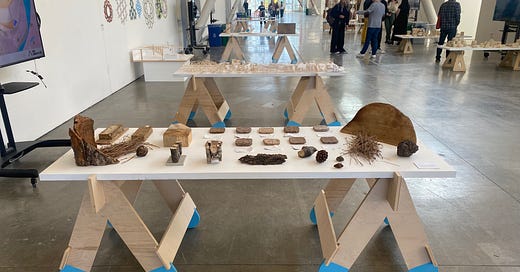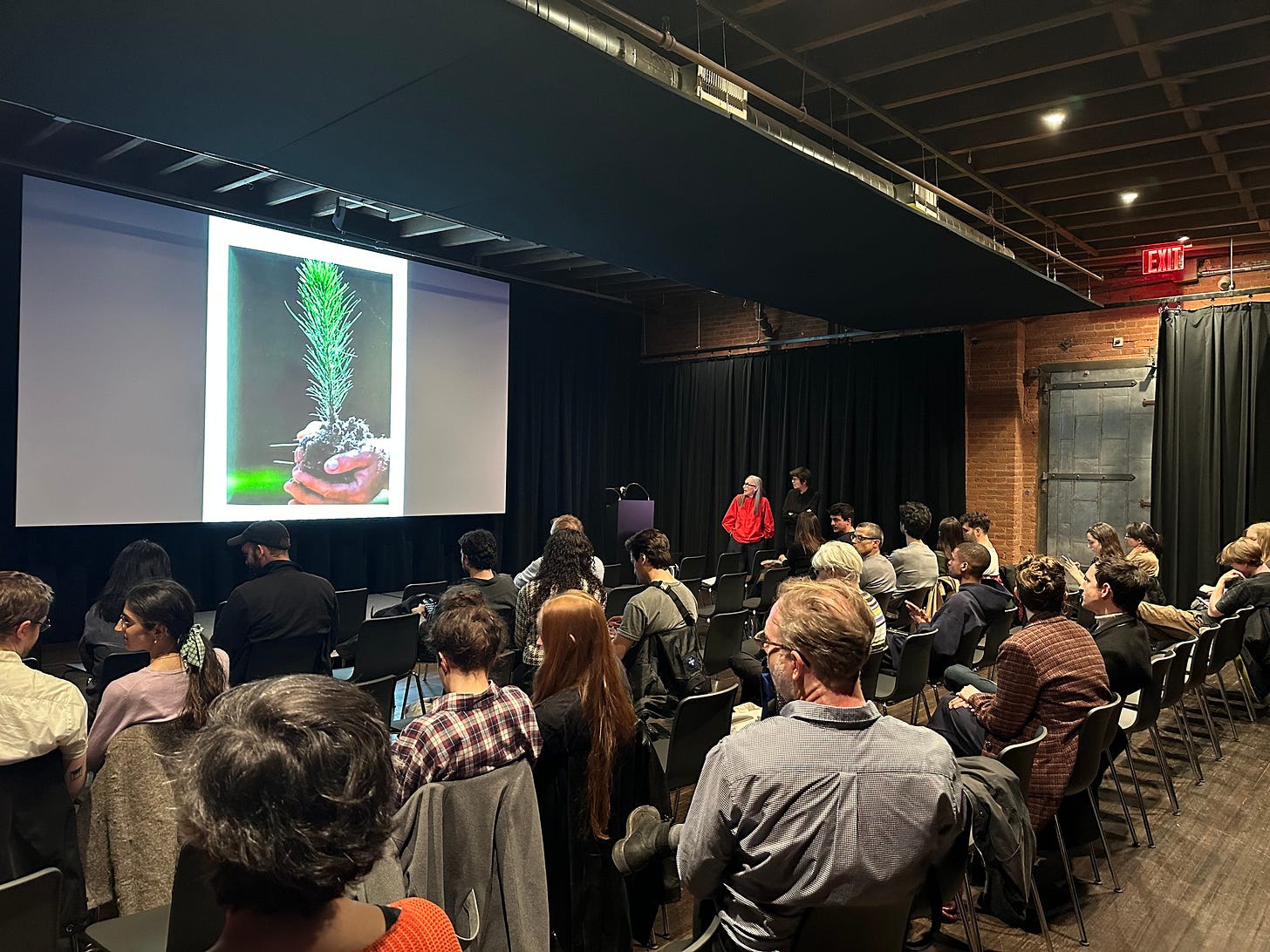S K Y L I N E | Making good use of monuments
With Krysztof Wodiczko, Sylvia Lavin, Moshe Safdie, Boonserm Premthada, and more
Issue 111. We are pretty good online but we are even better in print. But don’t take our word for it: Subscribe today, we will send you an issue, and you can make your own call.
If you want to know what is on my mind, it is guns. I am from Kansas City, where city planners, trying to make streets seem closer to the center of town than they actually were, gave almost every ‘street’ an accompanying ‘terrace,’ so that, for instance, what would have been 148th street and 149th street are instead 74th street and 74th terrace. When I was home for Easter two weeks ago my dad, who lives on a ‘terrace,’ charged out the door to collect a package that was sent to his address on a ‘street’ — it happens all the time. It was a funny piece of trivia about my hometown until it got Ralph Yarl shot last week. It is nuts that we have so many guns in this country that ringing the wrong doorbell or going up the wrong driveway could prove fatal. It is nuts that my daughter will grow up attending shooter drills that will provide no real security. It is not, however, so nuts that none of the five dispatches below from conversations around architecture this week touch on guns. We cannot and should not look to buildings to solve this problem. Only political action — advocacy, donations, volunteering, voting — will do that.
— Nicolas Kemper
(As a programming note, next week we are in production with our new print issue, so we will not be publishing SKYLINE. Fear not, your Friday discourse fix will be back in May.)
DISPATCHES
4/15: Practice and Praxis
San Francisco — “What is the difference between practice and praxis?” the Thai architect BOONSERM PREMTHADA wondered aloud in the second session of CCA Architecture’s Climate as Praxis symposium. Premthada went on to admit that he Googled the question. I’ll admit, I asked Chat GPT:
"Practice" refers to the act of repeatedly doing something to improve or achieve mastery, often guided by established methods, techniques or principles. For instance, a musician practices their instrument to improve their skills and to perform better.
"Praxis", on the other hand, refers to the practical application of theoretical knowledge or principles, often in a social or political context. It is a way of putting theory into action, often with the aim of effecting social change. For example, a social activist may engage in praxis by using theoretical concepts to guide their actions and create meaningful social change.
In summary, while practice refers to the act of doing something repeatedly to improve, praxis is about applying theoretical concepts to real-world situations to effect social or political change.
Climate as Praxis was the inaugural symposium of the M. Arthur Gensler Jr. Center for Design at California College of the Arts (CCA). The event was divided into two sessions representing two scales: “Session One: Land and Territory” featured Kate Orff of SCAPE and Chris Cornelius of studio:indigenous, while “Session Two: Materials and Tools” featured Billie Faircloth of KieranTimberlake and Boonserm Premthada of Bangkok Practice Studio. Covering a little bit of everything all at once, the presentations cycled through projects that over 20 or so years shifted from the fringe to the center, challenging existing systems and power relations through social action, data, organization, and design. In the Q&A, both sets of speakers landed on a familiar refrain: that humility and empathy makes for better buildings, landscapes, policies, and people.
— Vivian Schwab
4/16: A tale of four architects…
Last Sunday I attended the first public reading of a new play by OREN SAFDIE, Façade, at Urban Stages. I sat behind the playwright’s father, MOSHE, two guests, and the critic PAUL GOLDBERGER. It was a prime position to take in a script exclusively focused on the strained personal and professional relationships between two architect couples who are friends... until one pair demolishes the other’s building to make way for their own. If that sounds familiar, that’s because the script was “inspired by” (not “based on,” as Safdie pointed out in the post-reading discussion) a well reported saga of New York archi-drama. The expressions of that front row became like anemometers for the complicated high-wire walk of literary inspiration. The play frequently dropped real-world industry names—some certainly known by the elder Safdie—and caricatured conversations reliably had in every office and school studio. Goldberger even found himself thrown to the winds, when one of the quartet declared her partnership above the need for positive press; “we’re critic proof.” Safdie suggested this play might be his final one on architecture, the last in a quintet focused on breaking down the barriers between what he sees as a hype-insular profession and everyday life for everyone else. Hopefully this script will be realized in a full theatrical run so more than the small crowd assembled can experience the keenness of his observations and the insightful complexity of his transmission. “Without saying more than I would want to say”, avouched Goldberger, “you did kinda get those four people right.”
— Nicholas Raap
4/18: “Generator’s Vital Infrastructure”
CLINTON HILL — On Tuesday night, Princeton professor SYLVIA LAVIN kicked off the e-flux architecture lecture series at the platform’s new Classon Avenue space. Her talk, informed by material from her forthcoming book on trees, was a focused inquiry into Cedric Price’s Generator project (1976–80), which imagined a kind of kinetic cultural complex for White Oak Plantation in northwest Florida. Lavin emphasized certain aspects of the project’s supple program, involving simple modular enclosures set amid a vast forested swamp that could be endlessly reconfigured to suit visitors’ desires. She also made compelling narrative use of the Generator’s conceptual and material pedigree: Price’s client was Howard Gilman, the chairman of the Gilman Paper Company and New York arts philanthropist. (The opera house at BAM bears his name.) Invoking the “generative” forces of nonlabor and labor-intensive activities, Lavin paradoxically highlighted the material agency of the unconscious. She went on to elucidate other elements of the scheme (e.g., a historical slave hut that evaded Price’s grid plan) in ways that defy summary description. Her argument was ultimately couched within the theoretical space of the archive, which can’t help producing a sensation of ambivalence. The archival deep dive doesn’t readily produce answers or determinations so much as paper trails.
— Ruo Jia
4/18: And the Worlds that Surround
UNION SQUARE — On Tuesday, the new documentary by ERIC FRANKLIN ROMEO, And the Worlds that Surround, screened at the New School’s Tischman Center as part of its Earth Day programming series. Romeo, who is an architect, vividly captures the muck of New York’s waste plants and subway tunnels, even as he zooms in on its fine-grain textures (ants crawling over discarded raspberries, raindrops balancing on blades of grass). He opts for tight framing that cuts off the tops of windows and people’s chins, preventing us from seeing neat separations between people, ecosystems, and infrastructure. FRITZ MEYER’s score, performed live by a cellist and violinist duo, glides and swells over the ambient noise of city streets. During the Q&A, audience members struggled to find the meaning of the film’s visual juxtapositions. Romeo explained that he wanted to create a cinematic version of New York that was “more than a wall of steel” and invited viewers to consider the unremarkable sides of urban life. Where Romeo succeeds is in paying close enough attention to find their beauty.
— Tim Cox
4/20: What if Monuments Could Speak?
As fights about what to do with problematic monuments simmer across the world, last night at Columbia GSAPP Krysztof Wodiczko asked a different question: When monuments are “invisible and unemployed between upheavals,” what do we do? Wodiczko presented a series of pieces spanning the last 25 years in which he would record people telling their stories and then project them onto monuments—such as a projection of mothers talking about gang violence onto the monument on Bunker Hill (1998). Wodiczko argued that we are constantly “imagining ourselves on pedestals” and so when we see someone else occupying them we have to “accept and understand them.” But his interviewees were not the only intended beneficiaries: Wodiczko concluded by saying that he believes his art makes the “monuments feel better,” and that the best way to “preserve and protect monuments is to make some good use of them.”
— Adam Oscar Brodheim
EYES ON SKYLINE
The most clicked link in last week’s issue was Hellgate’s piece about how not just anyone can afford the affordable housing in Sauron’s new perch in Brooklyn.
IN THE NEWS
…Deborah Berke Partners is now TenBerke…
…Anjulie Rao asks that architects consider being followers instead of leaders…
…a man got trapped inside a piece of public art in Canada…
IN RAT NEWS
The New York Times assembles “Rat horror stories” for the new rat czar.
DATELINE
Monday, 4/24
Contextualizing Africa Panel + Exhibition with Stella Mutegi, Kabage Karanja, Cave_bureau, Issa Diabaté, Koffi & Diabaté Architectes, Moreno Castellano, Eloisa Ramos, & Ramos Castellano Arquitectos
12:00 PM CDT | Rice University School of Architecture & NOMAS Rice University
Book Launch—Gathering: Ongoing Work by Current Interests with Mira Hasson Henry & Matthew Au
6:00 PM EDT | Princeton University School of Architecture
Balancing Architectural Works and Social Contribution with Shigeru Ban
6:30 PM EDT | Yale University School of Architecture
Lecture with Walter Hood
5:30 PM MDT | University of New Mexico School of Architecture and Planning
Tuesday, 4/25
Vkhutemas: Laboratory of Modernism, 1920–1930 with Anna Bokov & Steven Hillyer
6:30 PM EDT | Cooper Union
Wednesday, 4/26
What Black Is This, You Say? Symposium
6:00 AM EDT | Cooper Union
Thursday, 4/27
Lewis Mumford Lecture: Pressing Change in the Increasing Inflexible City with Emily Badger
6:00 PM EDT | Spitzer School of Architecture
Some Characters in Search of An Author with Cecilia Puga & Paula Velasco
6:00 PM EDT | Princeton University School of Architecture
Friday, 4/28
WOJR: Organization for Architecture with William O’Brien, Jr.
4:30 PM CDT | University of Wisconsin-Milwaukee School of Architecture
Our listings are constantly being updated. Check the events page regularly for up-to-date listings and submit events here.
LETTER TO THE EDITOR
Want to chat? Write us a letter! Simply reply to this e-mail. We will reply.
New York Review of Architecture reviews architecture in New York. It is a team effort. Our Editor is Samuel Medina, our Deputy Editor is Marianela D’Aprile, and our Publisher is Nicolas Kemper.
To pitch us an article or ask us a question, write to us at: editor@nyra.nyc.
For their support, we would like to thank the Graham Foundation and our issue sponsors, Tod Williams Billie Tsien Architects and Thomas Phifer.
To support our contributors and receive NYRA by post, subscribe here.







